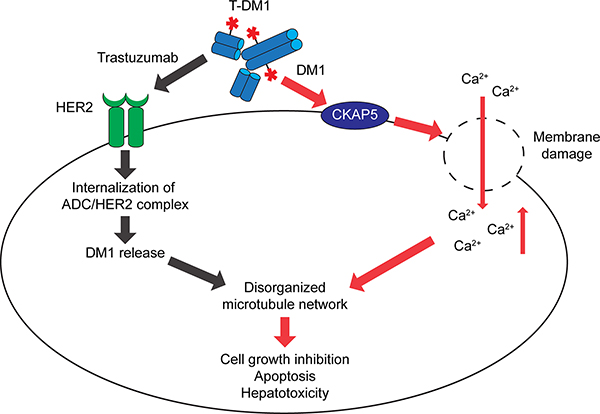Oncotarget Volume 9, Issue 98 reports upon binding to CKAP5, T-DM1 causes cell membrane damage and leads to calcium influx into the cells, resulting in disorganized microtubule network and apoptosis.
While binding of T-DM1 with HER2 is critical for killing HER2-positive tumor cells, the research team's data suggested that cytotoxicity induced by T-DM1 interaction with CKAP5 may preferentially damage normal cells/tissues where HER2 expression is low or missing to cause off-target toxicity.
Dr. Wen Jin Wu from the Division of Biotechnology Review and Research I, Office of Biotechnology Products, Office of Pharmaceutical Quality, Center for Drug Evaluation and Research, U.S. Food and Drug Administration (FDA), Silver Spring, MD, USA said "Antibody-drug conjugate is an emerging new class of therapeutic drug for treatments of a variety of cancers."
"Antibody-drug conjugate is an emerging new class of therapeutic drug for treatments of a variety of cancers"
- Dr. Wen Jin Wu, Division of Biotechnology Review and Research I, Office of Biotechnology Products, Office of Pharmaceutical Quality, Center for Drug Evaluation and Research, U.S. Food and Drug Administration (FDA)
Typically, an ADC consists of three components: monoclonal antibody directed against an antigen overexpressed on the cancer cell surface, a cytotoxic payload, and a linker.
Upon binding to the cell surface antigen overexpressed on the tumor cell surface via antibody component, ADC is believed to be internalized followed by the release of payload that targets intracellular molecules to mediate cytotoxicity.
In particular, while biodistribution of small molecule payloads generally depends on chemical properties of the molecule, ADCs likely limit the distribution of payloads to where the antibodies are distributed, such as plasma space and antigen-expressing cells/tissues.

Figure 7: A working model: The payload (DM1)-mediated cytotoxicity. Upon specific binding to CKAP5 on cell surface of hepatocytes, T-DM1 begins to damage cell plasma membrane followed by osmolality changes inside of hepatocytes due to calcium influx. Increased calcium concentration in the cytosol causes disorganized microtubule network, resulted in cell growth inhibition, apoptosis and hepatotoxicity. While T-DM1 antibody-mediated interaction with HER2 plays a major role for ADC-induced killing in HER2-positive tumor cells, payload (DM1)-mediated cytotoxicity is particularly important for T-DM1-induced cytotoxicity of normal cells/tissues where HER2 expression is low or missing to induce "off-target" toxicity.
ADC instability and antigen-independent uptake by cells are proposed as two major mechanisms of off-target toxicity.
For example, ADCs may be taken up by normal cells through mannose receptors, Fc Rn, and Fc R receptors expressed on the cell surface.
The Wu research team concluded in thier Oncotarget Research Paper, "The present study advances our understanding of mechanisms for ADC-induced cytotoxicity and challenges the conventional concept for the mechanisms of ADC action when it targets normal cells to induce unwanted toxicity."
Sign up for free Altmetric alerts about this article
DOI - https://doi.org/10.18632/oncotarget.26461
Full text - https://www.oncotarget.com/article/26461/text/
Correspondence to - Wen Jin Wu - [email protected]
Keywords - cytoskeleton-associated protein 5 (CKAP5), antibody-drug conjugate (ADC), ado-trastuzumab emtansine (T-DM1), HER2, hepatotoxicity
About Oncotarget
Oncotarget is a biweekly, peer-reviewed, open access biomedical journal covering research on all aspects of oncology.
To learn more about Oncotarget, please visit https://www.oncotarget.com or connect with:
SoundCloud - https://soundcloud.com/oncotarget
Facebook - https://www.facebook.com/Oncotarget/
Twitter - https://twitter.com/oncotarget
LinkedIn - https://www.linkedin.com/company/oncotarget
Pinterest - https://www.pinterest.com/oncotarget/
Reddit - https://www.reddit.com/user/Oncotarget/
Oncotarget is published by Impact Journals, LLC please visit https://www.impactjournals.com/ or connect with @ImpactJrnls
Media Contact
[email protected]
18009220957x105


